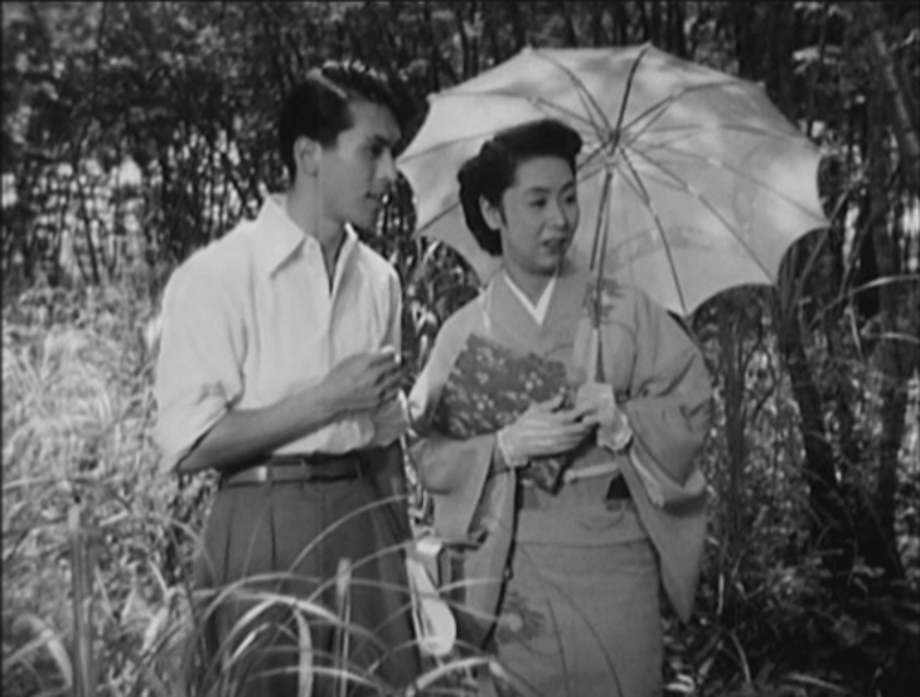THE LADY OF MUSASHINO
The film opens with distant roar of heavy bombing, as thick ribbons of smoke drift over the horizon. The war is at its last stage. A couple fleeing from the inner city is Michiyo (Kinuyo Tanaka) and Tadao (Masayuki Mori), who seek refuge in Michiyo’s parent’s home in Musashino. An old large estate with long history of Samurai family, the place is deeply etched with pride of the prestigious clan. Tadao, a sarcastic and decadent French literature professor, finds this luxurious atmosphere comfortable but feels alienated at the same time. He finds agreeable fellow citizens next door; Michiko’s cousin Eiji, a businessman, and his wife Tomiko. Tension is already building up.
Michiko’s mother dies as if she is cursed by the old skeletons buried deep in the garden, and her father survives her by just few months. On surface, Michiko and Tadao are living the life everybody envies; a large estate in quiet suburb, substantial inheritance and handsome income from Tadao’s publication. However, Tadao is quite vocal about his dissatisfaction. The estate is in his wife’s name, not his. There’s also a hint that Michiko is not particularly interested in sex with Tadao. Tadao always claims everyone should be more open about their sexual desire and adultery should be socially acceptable. He openly discuss matters of free sex in his class, boasts his ideas with his neighbors, who take his words half-seriously. It is apparent that his logic is not based on his experience; he is drawing the blueprint he himself fantasize reenacting sometime.
Then, Tsutomu, Michiko’s another young cousin, came back from a detention camp in tropics. Tsutomu becomes the center of the storm; he becomes Tomiko’s object of desire while his feeling gravitates toward Michiko. Soon, Tsutomu’s obsession tries to overturn their ‘clean’ relationship. Michiko, though attracted to Tsutomu, tries to hold her obligation as a married woman.
THE LADY OF MUSASHINO (武蔵野夫人) is released in 1951, under TOHO productions. It is based on the popular novel of the same title by Shohei Ooka (who also wrote the original novel of FIRES ON THE PLAIN), and the reception at the time was not particularly enthusiastic, nor damning. Most of critics found Kinuyo Tanaka’s characterization of Michiyo rather wooden, specifically compared with the character in the novel. But overall, it was a fairly good production with “a unified atmosphere (Juzaburo Futaba)”. Mizoguchi himself was not pleased with the outcome, and calling the year 1951 ‘unproductive’ (referring to his previous work “Miss Oyu” as well).
The most critical factor in the film (and its original novel) is the Musashino and its effect on people. This aspect of the film may be puzzling to those who are not familiar with our relationship to this particular region of Kanto. For example, Tsutomu’s obsession with Musashino might seem purely academic, collecting some legends and historical facts, plus geological interests. The tale about “Love Hollow” does support the psychological narrative while images of water reflects the nature of sexual undertone. But the film draws inspiration from much more than that. It is rooted in Japanese’s long obsession with Musashino, even dating back to 8th century.
Top : Kawagoe, Saitama, Bottom: Fuchu Tokyo,
Additional marking is at Koganei, the location of THE LADY OF MUSASHINO
musashino
History of Musashino
Musashino is not a specific city nor a county. It is a rather loose term describing the western region of Tokyo and Saitama. The literary meaning is “Plain of Musashi (-province)”, the large area of hills and slopes once belonged to Musashi Province (8th century to 19th century). Usually, it is considered the region between Kawagoe (Saitama) and Fuchu (Tokyo). Today, the region is densely populated suburb of the Greater Tokyo.
Musashino was once covered with ancient forests until deforestation and cultivation by the early settlers. By the 8th century, the proto-ecosystem of Musashino as we know it has emerged, according to some studies.
During medieval to feudal era, the large part of Musashino remained untouched. It was a slow process of several centuries to develop the vast land as agricultural backyard of Kanto. Even as late as Edo-era, the place was largely ‘blank’ in maps with only few names of villages and settlements. New Japanese Government of Meiji era created ‘Tokyo’, the center of Industrial Japan, but most of the development concentrated around Sumida River, the east part of the city. It took another century to transform Musashino into modern suburb. However, around this time, ‘Musashino’ began to sneak into vocabulary of Japanese literature, emitting quiet but mystic aura around it.
The most influential person who brought Musashino into literature was Doppo Kunikida. His work “MUSASHINO” is still a widely read book, and its influence did lend the place mystic and romantic aura. It was a revolutionary book; it offered different view or relationship to nature or landscape from what Japanese, especailly Eddoko, had previously. Eddoko loved cherry blossom along the banks of Sumida River in spring. They loved fireworks over the Sumida River in summer. They loved ‘something special’; seasonal festivals, colorful blossoms, sight-seeing …, anything extraordinary pleased them. Kunikida appreciated “nothing special”. He admired the landscape with no name, filled with trees, grasses and water, immersed in vastness of the earth. It resonated with the minds of the time, when central Tokyo was gradually transforming itself into another capital of industrial revolution.
But, unbelievable it may seem, Kunikida’s ‘Musashino’ is just a little west of what is Shibuya today. Yes, back then, Shibuya was still the fringe of Tokyo city. Beyond the Forest of Yoyogi, the place was mostly barren, with rice fields and farms in spots.
As THE LADY OF MUSASHINO suggests, the massive land development in the area started after the World War II.
Copyrighted materials, if any, on this web page are included as “fair use”. These are used for the purpose of research, review or critical analysis, and will be removed at the request of copyright owner(s).

